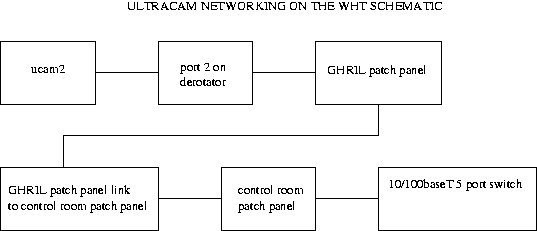Computing information for the ultracam system
P.Kerry 17/5/03
Networking
ultracam and ucam2 are connected via a private 10/100baseT (twisted pair)
networking system. This allows the system to be run without any need for
external networking facilites at telescope sites and increases networking
performance.
ultracam also has a second 10/100baseT network card which enables a standard
connection into an institutions network. Each network card is labelled internal
or external at the rear of the machine.
A standard (non-crossover) STP/UTP (shielded/unshielded twisted pair) cable
should be used to connect the systems.
Any port on the switch can be used (do not get confused with the symbols
for port5 which can be used as normal. For info - port 5 is additionally
able to handle straight through or crossover connections which is useful
only when connecting additional switches where a crossover cable is usually
used - this gives the option to connect via a straight through if you don't
happen to have a crossover around at the time).
The 100 Mbps LED's on the ports that are in use should light up when the
systems that are connected are powered up. Similarly, there are LED's on
the network cards that light up - usually one for activity and the other
is a speed indicator.
If the lights flash on the switch, then there is a probably a crossover
cable somewhere within the line. Using a crossover cable to return the
lines to normal will usually solve the problem.

As can be seen from the schematic above, this is a very simple network
in principal. The only difficulty being routing a cable (or using an existing
line) from the switch to ucam2 - observatory assistance may be required!
Networking on the WHT

Connect ucam2 to network port 2 on the derotator. This link then goes
into a patch panel in the GHRIL box which is usually connected to the switch
underneath the patch panel.
Disconnect the link to the switch and connect it to a patch panel port
that goes to the control room patch panel behind the telescope engineering
console.
Connect a cable from the control room patch panel to our switch.

